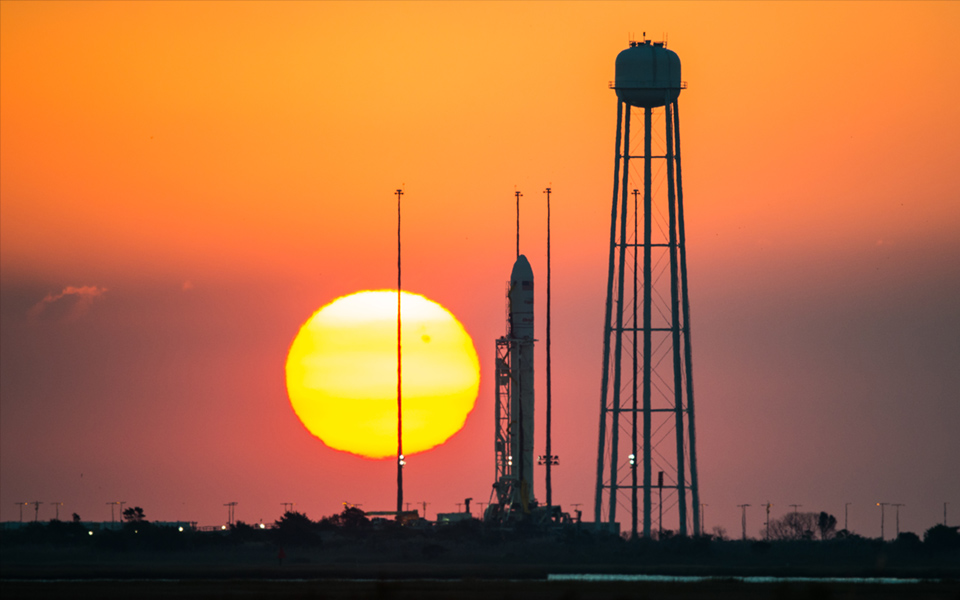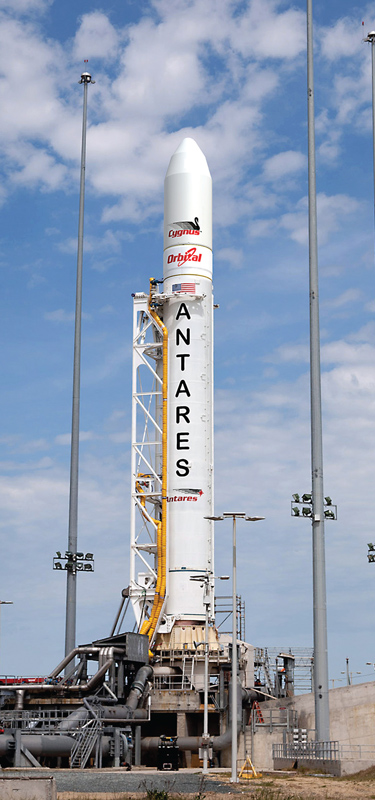
A very unfortunate incident for NASA and the commercial orbital transportation services program took place yesterday. The Antares rocket that was about to send the Cygnus spacecraft on the ISS exploded a few seconds after its launch from NASA’s Wallops flight facilities. No casualties or even small injuries were reported, although the area is being contained and treated with caution. It is a major incident for US spaceflight that breaks a trouble-free period and could have important implications for the private spaceflight sector.
The Antares launcher and the Cygnus spacecraft it was carrying were both developed and operated by Orbital Sciences corporation, one of the two private companies (along with SpaceX) under contract from NASA for supplying the International Space Station with cargo, supplies and secondary experimental, and commercial ISS payload. The video below shows that the explosion started from the base of the rocket, close to the nozzles, while the rest above was intact. The first stage engines are the major suspect but it is still too early to know exactly what went wrong.
As stated by NASA’s press conference, the flight termination system was activated. This is a remote manual intervention that initiates a self-destruction mechanism when the vehicle’s attitude is beyond recovery or control, in order to contain the damage from any explosion or debris in the launch area. As you can see in the launch video and the video below (shot from a small airplane from a distance) the explosion was huge. Even hours later, fires caused by kerosene and solid propellant were still burning.
Unlike SpaceX, which is almost completely vertically integrated, Orbital outsources most of its components and focuses on system integration and design. Antares is a two-stage rocket, and in its first stage it uses a pair of liquid propellant motors originally designed (and constructed!) during the ‘60s for the Soviet N-1 rocket. Despite their age, these motors are highly advanced, more so than most contemporary rocket engines. They were constructed as NK-33s in Russia but they are refurbished from US Company Aerojet (and renamed AJ26). It is too early to attribute the accident to these engines but it is worth mentioning that the use of Russian rocket engines from US operators recently became a very sensitive matter. The Ukraine crisis and the US/Europe sanctions are placing Orbital and ULA (the USA defense contractor for space launches that also use Russian made RD-180 engines) in an uncomfortable position. A side-effect of that crisis is a boost to the US private sector, which could step in and fill the gap created by the withdrawal of Russian engines from US launches.

That may be beneficial for the private sector in general but not so for Orbital, which could face delays until this mishap is resolved. Meanwhile, the competition from SpaceX and established companies like Lockheed and Boeing is very strong. During the press conference that took place shortly after the accident, NASA official stated their satisfaction from the way Orbital operates and their will to resume Antares/Cygnus missions after the accident investigation is resolved.
The COTS program, apart from its obvious mission of ISS resupply, also aims to validate the privately developed Dragon and Cygnus spacecraft. Both usually have room and payload to spare so they’re used extensively for transporting experiments. The Cygnus cargo vehicle destroyed on this accident was carrying a lot of small satellites owned by schools, universities and startups. For example, Planet labs, an earth imaging startup lost 26 small satellites that were on board. Orbital stated that the payload is insured, although the extent of the coverage and the details are different for each client and contract. The rocket and general hardware is also at least partially covered, and as stated on the press conference, NASA and Orbital will find a way to deal with the cost of any replacements.
Any correlation between payload and this accident is practically impossible, so the rules and requirements should not change for the next missions. However, Orbital’s system could take some time until it resumes the rest of its contracted missions, and the delay or additional modifications may raise the payload cost. It could also indirectly raise the payload cost for other operators simply by reducing supply. Insurance prices could also increase and the total cost for a school, research team or startup may be bigger for future missions. Nevertheless, today there is unprecedented activity over commercial spaceflight, even if we are still very far away from the glory days of nationally funded Apollo or Space Shuttle. Competition will certainly make access to space easier and cheaper for everyone, even with occassional incidents like this along the way.